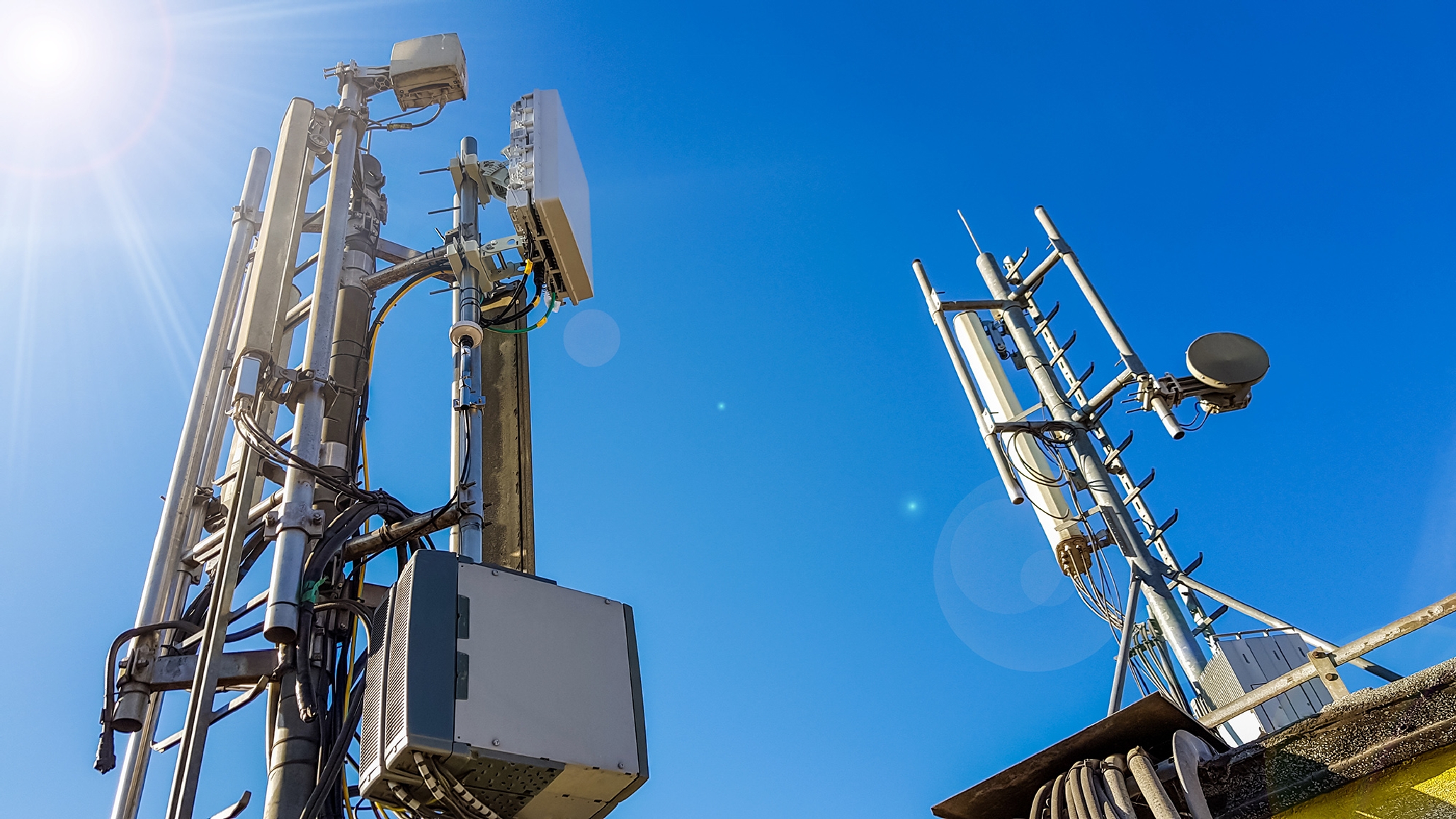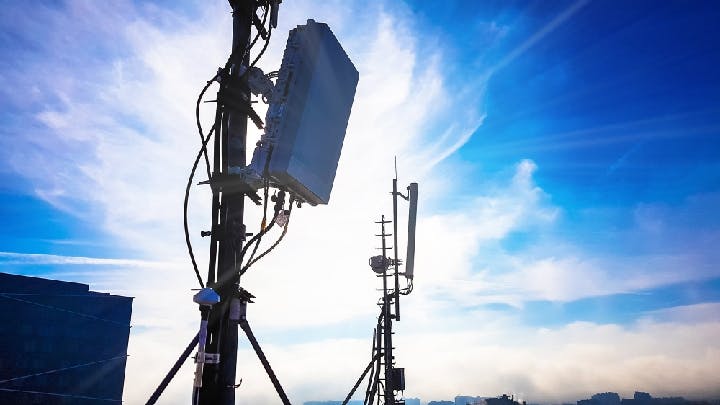Spring 2020
Coming Together
– Meg King
Can North America be the world’s new tech hub? How it implements 5G technologies and a new trade deal will be key indicators.
You step outside the office and need a ride, but that pesky location pin on the rideshare app isn’t in the right place. So you furiously tap out a message to your driver.
You refresh the screen to see if the car has moved closer to your physical location. But your app freezes – and the car suddenly jumps a few blocks. Refresh again. The “spinning circle of death” continues its movement. As you watch the battery level on your phone plummet to 1 percent, you give up and shove the phone in your pocket.
Hang in there. The solution is coming soon – in the 5G telecommunications networks now being built and installed in North America.
North America is ready for the upgrade. The Global System for Mobile Communications Association (GSMA) observes that the region shares the world’s largest market for mobile technologies – with a demand that is “around 50 percent greater than China.” There are also a lot of mobile phone users – 321 million of them at last count.
Sure, China and India both have more total users, but the important thing is what these users do. In North America, consumers spend a lot of money on mobile services.
Fifth generation technology has been a decade in the making, but it is finally a reality in North America.
By 2023, the GSMA predicts spending on mobile technologies and services in North America will reach $1.2 trillion – representing 4.8 percent of GDP. Ericsson expects the region will have the highest adoption rate in the world over the next few years, with more than half of mobile subscriptions using 5G.
North America wasn’t a “first mover” on the last generation network. But the continent eventually gained leadership in 4G technology. It did so by moving rapidly from a solid foundation.
As 5G looms on the horizon, how can we repeat that success? We can do it by banding together to collaborate and making use of our favorable and unique position as a region. Taking full advantage of the fruits of a new North American trade agreement also will help forge our path forward.
A Boost for Business
How did we get here? Just follow the numbers.
First generation, or 1G, telecommunications technology enabled voice transmission by analog radio signals. Digital voice transmission and text messaging were ushered in by 2G. Subsequent generational leaps added wireless data and internet access (3G) and video transmission (4G).
The advent of 5G will be a rocket ship for data and video by comparison – with predictions of speeds of up to 20 times faster than 4G. The new technology also means more devices can use a network without degrading service.
A growing deployment of small cell solutions will enable less power draw from devices, making it possible to still catch your rideshare even if you have scant battery life left. Fifth generation mobile networks will minimize delay in services provided by the apps you use (also known as low latency), among many other life-saving and economy-booming services. That spinning circle of death will be a relic of the past.

Better service is only the beginning of 5G’s expected benefits for North American consumers. But the initial benefits of this technological leap will flow to businesses.
Just-in-time manufacturing will get even faster, and the process of transporting goods (from shipping to vehicle fleet management) will draw upon more efficient logistics. The deployment of 5G will help agriculture shift tactics more precisely according to weather forecasts, and produce advances in mining and in construction – including more efficiencies in building design and utility consumption. Public safety and healthcare will also benefit from the new technology.
Real-time services will also see a major boost. Why? Because 5G’s smaller, faster antennas will make sensor connectivity with a larger bandwidth practical -- and a network with more device capacity and increased speed should allow more data transmission.
Coordination – at both the policy and technical levels – will be necessary across regional governments and private sectors to make best use of the new trade deal’s rules.
Headlines trumpet a race to build 5G networks. They say the future belongs to those who do it fastest. But it’s much more complicated; infrastructure is just the beginning. Once 5G networks are in place, they have to be used. Digital trade will surge across those new networks.
This is why cutting red tape as a region – to let improved digital trade flow freely – is so important. The new North American trade agreement promises to help make that happen.
A New Chapter
When the North America Free Trade Agreement (NAFTA) went into effect in 1994, the internet was still a new tool. It was so new, in fact, that it wasn’t even named in the agreement.
The economic potential of new information communications technologies was not clear to most policymakers in 1994. But in the last decade, America’s digital trade with Canada and Mexico added $19 billion to the US economy.
So addressing digital trade was arguably the single most important component of the new US-Mexico-Canada Agreement (USMCA). One of the chapters of the new deal (Chapter 19) offers new provisions to create certainty in key transactions such as electronic contracting and guidelines for data transfers across borders. Businesses craves such predictability, especially as they shape growth in their newer product lines.

Take what comes through your earbuds. Eighty percent of all recorded music revenue last year came from streaming services. Recording Industry Association of America CEO Mitch Glazier observes that “music is by far the biggest draw to tech platforms, gaining views and listens that generate enormous revenues for distributors.” New rules of the road laid out in Chapter 19 to make trade in digital products like music easier and cheaper will allow companies to plan better and invest more.
Like duty-free shopping in an airport, USMCA seeks to create a “duty-free internet.” Chapter 19 prohibits “customs duties, fees, or other charges on or in connection with the importation or exportation of digital products transmitted electronically,” so music streamed or software shared across the border will not incur additional taxes. Guarantees that no party to the agreement can “prohibit or restrict cross-border transfer of information...by electronic means if this activity is for the conduct of the business of a covered person” are also in place.
The changes wrought by Chapter 19 range from simple to profound. The agreement seeks an end to paper pushing by requiring each nation to “accept legal validity of a signature in electronic form” so that transactions can speed up. It also protects the crown jewels of digital applications: source code – and specifically the “algorithms expressed” in that code. As Wilson Center Fellow Ben Buchanan observes, “nothing is more important than what is in the source code.”
Now that USMCA ratification is across the finish line, the leaders of each country must urgently collaborate to embrace key elements of this proposal.
Indeed, intellectual property issues are at the heart of the new trade provisions. The USMCA provides standard protections against misappropriation of trade secrets, including those held by state-owned enterprises. It also offers an array of civil and criminal procedures, remedies, and penalties. There are concrete prohibitions against impeding the licensing of trade secrets, judicial procedures to prevent their disclosure during litigation process, and penalties for government officials who disclose them in an unauthorized fashion.
The theory undergirding these new provisions is clear. By removing barriers to digital trade, more services will be bought and sold. And key protections for those who do trade will tamp down anxieties about intellectual property.
As data is a fairly inexpensive thing to move across borders – compared to cars or farm equipment, for example – this should create an economic boon. Some people argue that data generated by today’s cars is more valuable than the vehicle itself, offering critical information for parking services as well as data to insurance companies in order to prevent more auto accidents.
Canada’s legislature made that nation the last signatory to approve the pact on March 13, 2020. But ratification of USMCA is only half the battle. Implementing Chapter 19’s sweeping new provisions to ensure the free flow of data securely and efficiently across borders will be much harder.
A Geopolitical Asset: Why the New Rules Matter
Adopting new rules for digital trade provides key definitions for an industry that can be hard to grasp concretely.
Data is an abstract word to most people. Fundamentally, data is information, especially in the form of facts and numbers, which is collected, examined and used to inform decision-making. This includes electronic information that can be stored and used by computers.
This information can take many forms, both raw (the combination of ones and zeros known as binary data) and refined (movies, e-books, videos, music, software, and games.) Binary format allows data to be created, processed, saved and stored digitally, and therefore facilitates data transfer between devices with the help of network connections.

As slippery as the term may be, all that data – when processed in a format useful to consumers – is worth a lot of money to North American economies.
Smart manufacturing is one sector in which new rules will matter greatly. Once North America’s 5G network is fully functioning, today’s just-in-time shipping will become almost an art form. Using 5G-enabled tools like edge computing, which brings processing as close to the source of data as possible, and extended Wi-Fi, the components of a particular widget will communicate through sensors to factories about exactly how long they will take to arrive – down to the minute. Integration of new parts will happen seamlessly, and widgets will speed from warehouse to customers.
Though the structures are in place, we can’t anticipate all of the economic benefits expected to flow into the region yet.
For instance, government data is in demand. Its accuracy is part of what makes it so valuable. Department of Motor Vehicle registrants must provide verified names, addresses and car registration details to get a license. California’s Department of Motor Vehicles recognized this and now generates $50 million a year in revenue by selling its data. And they are not the only agency doing so.
Through the USMCA, the U.S., Mexico and Canada are preparing to promote open access to similar government-generated public data. The agreement stipulates that they will “endeavor to cooperate to identify ways in which each Party can expand access to and use of government information.”
Better service is only the beginning of 5G’s expected benefits for North American consumers
The worth of this data raises the question of what data sets might fetch if anonymized and shared securely. Census data? Transportation data? Judicial data? Tax revenue data? The possibilities seem endless.
Of course, not all data is equal. Quality still matters over quantity. If data isn’t labeled properly, it’s not that useful. And if it isn’t diverse enough, a machine learning algorithm won’t offer the most accurate prediction possible. For example, in the healthcare sector, data abounds about white males, but not about women or other ethnicities.
Good data promises key insights that may alleviate vexing regional problems, or make processes such as digital trade more efficient. The rewards for companies will also be significant, which also makes privacy a priority. Protections must be put in place to assure North Americans that their data is secure, and can be negotiated as part of the agreement’s implementation conversations.
What matters most is that the cooperation that forged the agreement is also present as it is implemented. Coordination – at both the policy and technical levels – will be necessary across regional governments and private sectors to make best use of the new trade deal’s rules.
Can North America be the world’s new tech hub?
Last year in an article in the Yale Journal of International Affairs, I proposed four ways that North America could build on the momentum created by ratification of USMCA:
Develop North American innovation incubators in each country.
Create mechanisms to aggregate streams of data generated by each nation – including in some way by the private sector.
Develop a legal framework for sharing technology ideas.
Hold an annual summit to develop a regional strategy and accomplish the first three tasks.
Now that USMCA ratification is across the finish line, the leaders of each country must urgently collaborate to embrace key elements of this proposal. Talking is the best place to start. An annual summit – perhaps coordinated through implementation meetings, and organized by the trade negotiating teams – can help define and advance these ideas. The committee on competitiveness created by the USMCA, is an excellent venue to jump start this conversation.

The good news is that Mexico and Canada are already gearing up – and ready to talk. Alejandro Navarrete, head of the Federal Telecommunications Institute (IFT) – Mexico’s independent telecommunications regulatory body – told a journalist in January 2020 that 5G will have eventual repercussions throughout the country.
“It will not start immediately,” Navarrete observed, “but in a year it will be displayed everywhere.” Though the groundwork is starting to fall into place, he predicted bidding processes for spectrum and broader rollouts of the technology “in the next five to ten years.”
Canada is even further along the track, with initial consumer deployments in downtown Vancouver, Toronto, Ottawa and Montreal, and more markets rolling out later this year. In a speech at the 2019 Canadian Telecom Summit last June, Navdeep Bains, Minister of Innovation, Science and Economic Development, said that 5G was a “game changer” for his nation.
“5G will be a massive job creator and an economic driver – it’s expected to add $40 billion annually to our economy by 2026,” said Bains.
Willingness to get started and to talk through the issues is a start. But implementation is bound to be bumpy – especially when there is a new provision with a fairly short economic and legal history involved. Key players should use their time together in the room wisely.
Annual tech summits could be a site where the three countries ensure that policies and regulations are in line with technical capabilities. When advances occur, the three governments need to be ready to act. They would also be a venue for agreeing upon solutions to stickier issues – such as the best way to share data.
Once North America’s 5G network is fully functioning, today’s just-in-time shipping will become almost an art form.
Regular summits would also help accomplish the most difficult item of all: creating a legal framework to protect the sharing of new technology ideas of benefit to the region. As technology and innovation continue, we may discover that 5G will only be the first challenge of many to come.
Fifth generation technology has been a decade in the making, but it is finally a reality in North America. Several telecommunications companies are rolling out 5G networks, but they have thus far proven extremely limited in scope.
For now, carriers will continue to piggyback off already established 4G networks. Early deployments will place 5G equipment on already existing macro-cell sites, and increase the number of small cells to supplement network lags in high-density metropolitan areas.
With its far-reaching macro-cell sites and strong 4G spectrum, North America is primed for an accelerated 5G implementation process. A more comprehensive, nationwide rollout is expected to take place in 2021.
What will the next wave look like? Urban and suburban new-build sites will be created to complement the dense initial small-cell network installations. New partnerships will develop, like the one just announced between AT&T and Google Cloud, which will provide edge computing for AT&T’s 5G network. These collaborations can – and should – happen across North American borders.

The USMCA will be tested during this period of building and implementation. North America has many built-in advantages to lead in 5G technology deployment and usage, but it needs a strategy to do so, and fast.
Global leadership in emerging technology is up for grabs; North America just needs to raise its hand.
Meg King is the Director of the Wilson Center’s Science and Technology Innovation Program.
Thanks to Public Policy Fellow Ambassador Earl Anthony Wayne, Canada Institute Director Christopher Sands, Mexico Institute Director Duncan Wood, Global Fellow Guadelupe Correa-Cabrera, and Sophie Goguichivili for their assistance.
Cover photograph: A 5G smart cellular network antenna base station on a telecommunication mast. (Image by TPROduction via Shutterstock.)
